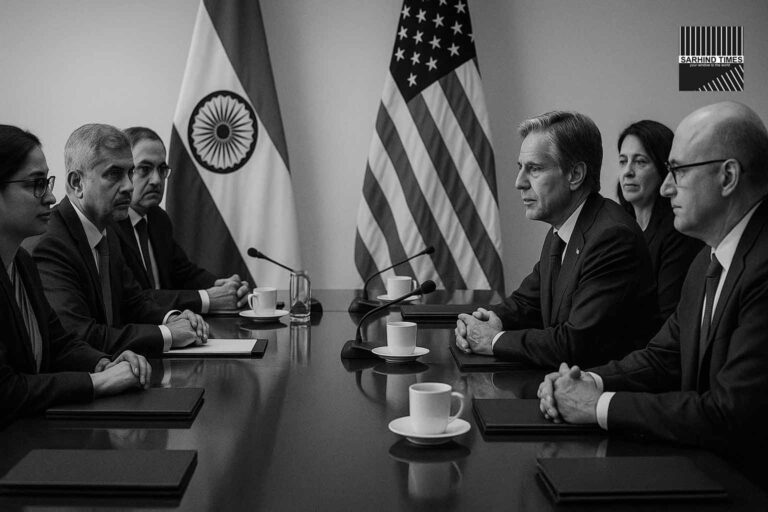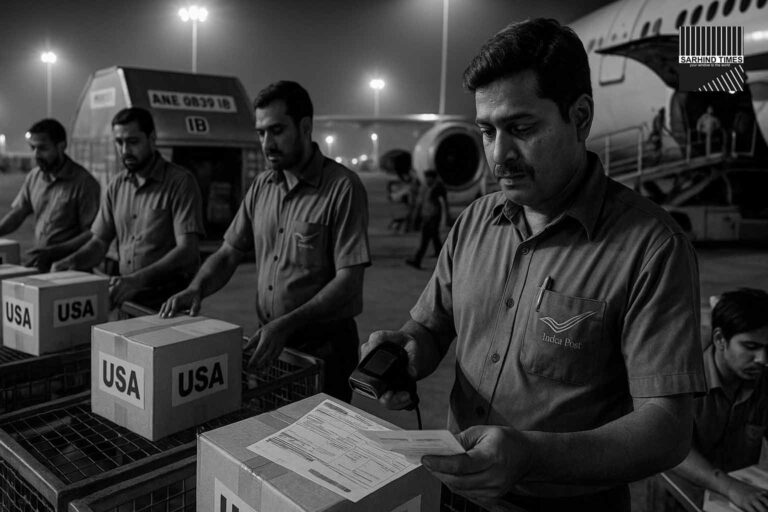Subhead: India is open to a trade “understanding” with the United States, External Affairs Minister S. Jaishankar said, but only on terms that respect New Delhi’s bottom lines—most notably farmer interests, policy space for strategic autonomy, and fair treatment on tariffs. He called certain US tariff actions “unfair,” even as broader cooperation stays on track.
Dateline: NEW DELHI | Monday, October 6, 2025
External Affairs Minister S. Jaishankar on Sunday signalled a firm—but not closed—Indian posture on the long-running India–US trade wrangle. Any deal, he made clear, “has to be an understanding where our bottom lines, our red lines are respected,” while both sides keep working to find a mutually acceptable “landing ground.” He also criticised US tariff moves—particularly those linked to India’s purchase of discounted Russian crude—as “unfair.”
Speaking around ongoing economic dialogues (including supply chains, semiconductors, and digital trade), Jaishankar’s message was calibrated: India is actively engaging yet unwilling to cede on core domestic priorities. He acknowledged “problems” in the trade track, but underlined that a deal remains both desirable and possible if the United States recognises where India cannot compromise.
The state of play: firm lines, open door
In remarks carried by multiple outlets, Jaishankar repeated two key phrases that now anchor India’s stance: “red lines” and “landing ground.” The first is a warning shot—there are non-negotiables for India. The second is an invitation—find the overlap that allows progress. “There are things you can negotiate and things you can’t,” he said, adding that New Delhi and Washington have “not arrived at a landing ground” yet.
Those red lines encompass at least three sensitive areas, according to policy watchers and Jaishankar’s own framing in recent appearances:
- Farmer & food-security space: India wants headroom to run support schemes and market interventions that underpin rural livelihoods.
- Strategic autonomy in energy: The freedom to source energy—including Russian barrels—without being singled out for penalty tariffs.
- Policy space for industrialisation: A measured path on tariffs, localisation, and incentives to build manufacturing depth.
On the second, Jaishankar was explicit: tariffs associated with Russian oil purchases that “pick on us” are viewed in New Delhi as “very unfair.”
What Washington wants vs. what New Delhi needs
Behind the rhetoric lie familiar asks on both sides. The US has historically pressed for lower tariffs, predictable digital rules, market access in goods (from dairy to medical devices) and services, and fewer localisation barriers. India, for its part, has sought relief from Section 232/301-style tariffs, a fair shake for labour-intensive exports (apparel, leather, gems & jewellery), greater mobility and services access, and policy confidence that domestic subsidies/incentives—from agriculture to clean tech—won’t be kneecapped by sudden trade measures. Jaishankar’s “red lines” compress this mosaic into a single line: respect the bottom lines, and we can do business.
The minister’s insistence on farmer protections and energy security reflects politics and arithmetic. With a vast rural electorate and a still-climbing per-capita energy curve, India treats these as security issues, not mere trade chips. New Delhi’s calculus: agreements that expand opportunity are welcome; conditions that shrink domestic elbow-room are not.
The “unfair tariffs” flashpoint
Jaishankar’s sharpest words targeted what he framed as unfair US tariffs tied to India’s energy sourcing choices. He argued India has been singled out despite others purchasing Russian oil at various points in the crisis. Clips and reports from the weekend echoed the same theme: “unfair,” “picked on us,” with a nudge to dial down the penalties and talk it through.
The point is strategic: penalising India for securing affordable energy during a fraught period not only raises domestic costs but also risks politicising a relationship that has—by design—grown well beyond trade: from the Quad to critical tech, space, and defence industrial tie-ups. New Delhi’s view is that economic friction should be de-risked, not allowed to contaminate the strategic track.
Reading the tea leaves: how a “landing ground” could look
A landing ground is not a maximalist FTA. Think of it as a targeted, modular package—narrow tariff reliefs, clearer digital norms, pilot mutual recognitions, and sectoral guardrails—that keeps the strategic engine humming while preventing new potholes on the trade lane.
Possible contours policy hands are gaming out:
- Tariff swaps: Limited concessions (e.g., on select industrial inputs or consumer goods) offset by reciprocal access in niches where India seeks to scale exports.
- Standstill & consultation clauses: Commitments to avoid sudden tariff hikes or penalties without prior structured dialogue, especially on energy.
- Semiconductor supply-chain cooperation: Fast-track lanes for equipment and spares; joint R&D windows attached to trusted supply principles.
- Digital & data interim rules: A do-no-harm pledge pending fuller regimes—stability for cross-border services while India refines its DPDP and digital competition frameworks.
- Agri comfort language: Recognition of India’s public-stockholding and procurement realities, plus room for smart subsidies that don’t distort global markets.
In other words: precision engineering, not grand constitutional redesign.
Impact lens: who gains, who worries
Agriculture & food chains. If “farmer red lines” hold and are acknowledged, it may ease political anxiety at home while keeping space for procurement and PDS-linked buffers. Exporters in spices, marine products, and processed foods could gain if non-tariff frictions are smoothed—lab testing, certifications, and seasonal quota clarity.
Energy & industry. Any de-escalation on oil-linked tariffs cuts uncertainty for refiners, airlines, and logistics. It may also soften input costs for manufacturing, improving export competitiveness. If a landing ground also tidies up clean-tech classifications (cells, batteries, electrolyzers), domestic manufacturing incentives can be aligned with trusted-partner sourcing.
Tech & services. Greater certainty on data flows, cloud localisation, and AI safety cooperation supports India’s services engine. For startups and SaaS majors, predictability in rules—and no overnight shocks—is the real prize.
Pharma & medical devices. Mutual recognition pilots for GMP inspections or device standards can unclog approval backlogs. The US wants pricing transparency; India wants market access without eroding domestic policy space on affordability.
MSMEs & logistics. Tariff stability and faster customs corridors (AEO, electronic pre-clearance, predictable testing) drop frictional costs that hurt the smallest exporters most.
Why this round feels different
Two macro factors are reshaping incentives on both sides:
- Geopolitical hedging: In a more fractious world, both countries are de-risking supply chains. India is central to China-plus-one calculus; the US is central to finance, demand, and tech. That gives each side reasons to contain trade fights.
- Domestic political clocks: With US politics in flux and India balancing rural and industrial coalitions, both capitals want trade wins without backlash—hence interest in modular understandings rather than sweeping FTAs.
Jaishankar’s formula—respect red lines; find a landing ground—is designed for exactly that.
The tariff thicket: what could move, what may not
Steel & aluminium: High-profile and symbolic. Even a modest unwind or quota-based comfort can signal goodwill without undercutting domestic lobbies.
Electronics components: Duty rationalisation on specific HS lines (lithium cells, camera modules, PCBs) would be noticed by India’s electronics value chains and US suppliers alike.
Agri sensitivities: Dairy has been a deal-stopper before. Here, pilot quotas or protocol-based access with safeguards might be the only palatable way forward—if at all.
Digital trade: The US favours free data flows; India seeks measured sovereignty. Expect interim consultative mechanisms rather than final-form rules.
Signals from the weekend—and why the language matters
Journalistic shorthand often misses the nuance in Jaishankar’s phrasing. “Red lines” can sound like a no-go, but paired with “landing ground,” it reads as conditional openness. The minister repeatedly said a trade “understanding” is both likely and necessary—if the US internalises India’s bottom lines. Reports across major Indian outlets captured exactly that balance on Sunday and Monday morning.
On tariffs, his “unfair” characterisation is not an anti-trade pivot; it’s a push to remove irritants that complicate larger strategic projects the two governments care about—semiconductors, defence co-production, critical minerals, space, 5G/6G R&D.
What to watch next (Oct–Dec 2025)
- Ministerial formats: Keep an eye on trade-adjacent platforms (supply chains, standards, investment facilitation) where micro-deals can be parked even if a bigger package stalls.
- Tariff signals from Washington: Any calibrated relief—or even a standstill pledge—on Russia-linked oil measures would unlock goodwill.
- Digital policy tempo in Delhi: The cadence of data, online competition, and AI rules will shape comfort levels for US firms—and thereby the tone of trade talks.
- Semiconductor pilot wins: Announcements on tooling, spares, and talent visas for India fabs would be a tell that the strategic-industrial track is insulated from tariff politics.
Bottom line
India is not closing the door on a trade deal; it is reframing the doorway. The task now is diplomatic carpentry: shave the edges, keep the frame strong, and let the two economies pass more easily through it. If both sides can codify respect for red lines and sequence the rest, a practical landing ground is within reach.
#IndiaUS #Trade #Jaishankar #Tariffs #StrategicAutonomy #Economy #Geopolitics

























+ There are no comments
Add yours